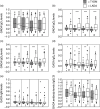The glutamic acid decarboxylase 65 immunoglobulin G subclass profile differs between adult-onset type 1 diabetes and latent autoimmune diabetes in adults (LADA) up to 3 years after clinical onset
- PMID: 19604265
- PMCID: PMC2730851
- DOI: 10.1111/j.1365-2249.2009.03939.x
The glutamic acid decarboxylase 65 immunoglobulin G subclass profile differs between adult-onset type 1 diabetes and latent autoimmune diabetes in adults (LADA) up to 3 years after clinical onset
Abstract
Autoantibodies against glutamic acid decarboxylase 65 (GADA) are found frequently in patients with autoimmune diabetes. Immunoglobulin (Ig)G(1) is the most frequent subclass among the GADA IgG subclasses. IgG(4) is a more common subclass in latent autoimmune diabetes in adults (LADA) at clinical onset compared to type 1 diabetes. The aim of this work was to study the different GADA-IgG subclass profiles during a 3-year follow-up in these groups of autoimmune diabetes. Adult-onset subjects, classified as either type 1 (n = 40) or LADA (n = 43), were included in the study. New samples were collected every year from these patients. In addition to conventional GADA analyses, GADA-IgG subclasses were also analysed with a radioimmunoprecipitation assay using biotin-conjugated antibodies (directed against human IgG subclasses and IgM) and streptavidin Sepharose. During 3 years' follow-up, all the IgG subclass levels decreased in type 1 diabetes - IgG(1): P < 0.001; IgG(2): P < 0.001; IgG(3): P < 0.001; IgG(4): P < 0.05 (Friedman's' test) - while levels remained stable for all four subclasses in LADA. GADA IgM, however, decreased in both groups (P < 0.001). Patients with LADA have higher GADA IgG(3) and IgG(4) at clinical onset and seem to maintain the levels and profile of their IgG subclasses up to 3 years after clinical onset, while all the GADA IgG subclass levels decrease in type 1 diabetic patients. This indicates a persistent different immune response in LADA compared to type 1 diabetes and further indicates the difference in pathogenesis.
Figures


Similar articles
-
IgG4-subclass of glutamic acid decarboxylase antibody is more frequent in latent autoimmune diabetes in adults than in type 1 diabetes.Diabetologia. 2004 Nov;47(11):1984-9. doi: 10.1007/s00125-004-1558-5. Epub 2004 Nov 24. Diabetologia. 2004. PMID: 15565370
-
Persistence of glutamic acid decarboxylase antibody (GADA) is associated with clinical characteristics of latent autoimmune diabetes in adults: a prospective study with 3-year follow-up.Diabetes Metab Res Rev. 2016 Sep;32(6):615-22. doi: 10.1002/dmrr.2779. Epub 2016 Mar 3. Diabetes Metab Res Rev. 2016. PMID: 26787598
-
Glutamic acid decarboxylase 65 autoantibody levels discriminate two subtypes of latent autoimmune diabetes in adults.Chin Med J (Engl). 2003 Nov;116(11):1728-32. Chin Med J (Engl). 2003. PMID: 14642146
-
[Latent autoimmune diabetes of adult or slim type 2 diabetes mellitus?].Arq Bras Endocrinol Metabol. 2008 Mar;52(2):315-21. doi: 10.1590/s0004-27302008000200019. Arq Bras Endocrinol Metabol. 2008. PMID: 18438542 Review. Portuguese.
-
Past, present and future of latent autoimmune diabetes in adults.Diabetes Metab Res Rev. 2020 Jan;36(1):e3205. doi: 10.1002/dmrr.3205. Epub 2019 Jul 31. Diabetes Metab Res Rev. 2020. PMID: 31318117 Review.
Cited by
-
Variation of C peptide decay rate in diabetic patients with positive glutamic acid decarboxylase antibody: better discrimination with initial fasting C peptide.BMC Endocr Disord. 2013 Mar 1;13:10. doi: 10.1186/1472-6823-13-10. BMC Endocr Disord. 2013. PMID: 23452723 Free PMC article.
References
-
- Groop LC, Eriksson J, Ekstrand A, Franssila-Kallunki A, Saloranta C, Miettinen A. Metabolic characteristics of autoimmune diabetes mellitus in adults. Diabetologia. 1991;34:46–51. - PubMed
-
- Tuomi T, Groop LC, Zimmet PZ, Rowley MJ, Knowles W, Mackay IR. Antibodies to glutamic acid decarboxylase reveal latent autoimmune diabetes mellitus in adults with a non-insulin-dependent onset of disease. Diabetes. 1993;42:359–62. - PubMed
-
- Zimmet PZ, Tuomi T, Mackay IR, et al. Latent autoimmune diabetes mellitus in adults (LADA): the role of antibodies to glutamic acid decarboxylase in diagnosis and prediction of insulin dependency. Diabet Med. 1994;11:299–303. - PubMed
-
- Carlsson A, Sundkvist G, Groop L, Tuomi T. Insulin and glucagon secretion in patients with slowly progressing autoimmune diabetes (LADA) J Clin Endocrinol Metab. 2000;85:76–80. - PubMed
-
- Zinman B, Kahn SE, Haffner SM, O'Neill MC, Heise MA, Freed MI. Phenotypic characteristics of GAD antibody-positive recently diagnosed patients with type 2 diabetes in North America and Europe. Diabetes. 2004;53:3193–200. - PubMed
Publication types
MeSH terms
Substances
LinkOut - more resources
Full Text Sources
Medical

